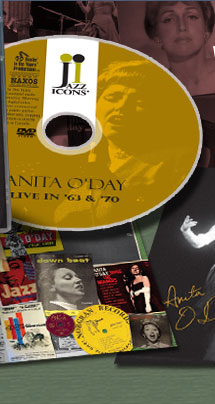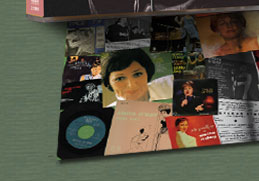




 |
 |
|
|||
|
|
|
||||
|
|
|
||||
|
|
|
||||
|
|
|
||||
 |
|
||||
 |
|
||||
 |
|
||||
|
|
|
|
|
|
|
Jazz Icons: Anita O’Day boasts two wonderful concerts from 1963 and 1970 that present the “jazz singer supreme” in impeccable form. O’Day’s horn-based approach to singing is in full effect throughout both shows including stand-out renditions in each show of audience favorites “Tea For Two” and “Sweet Georgia Brown” (both reprised from her triumphant appearance at the 1958 Newport Jazz Festival.) This DVD is a fitting testimony to one of jazz music’s true originals and shows unequivocally why she is ranked in the top tier of vocalists along with Ella Fitzgerald, Sarah Vaughan and Billie Holiday. |
|
 |
|
|
|
|
 |
|
|
|
|
|
|
|
Sample Liner Notes by Doug Ramsey: Stockholm, Sweden, June 25, 1963 Pianist Göran Engdahl (1938-2001) became a teacher, pursuing jazz as a parallel career. Jazz historian Lars Westin recalls that Engdahl “was considered one of the finest young pianists” in Sweden. The Polish bassist Roman Dylag spent many years in Scandinavia. The repertoire in Stockholm is typical of the songs O’Day sang following her triumph at Newport. She begins with one of her Newport tunes, “Sweet Georgia Brown,” swinging joyfully from the outset. “Let’s Fall In Love” discloses the rhythmic daring and elasticity of time in which O’Day surpassed all other singers. She gives “A Nightingale Sang In Berkeley Square” one perfect chorus. It has a sample of why Bill Kirchner admired Poole’s work with brushes. The close-ups of O’Day in “Fly Me To The Moon” show us an aspect of her art that was important to her success; her skill as a natural actress who used eye movement, posture, gestures and subtle changes of head position to illuminate her performance. Engdahl’s solo chorus reveals a bit of what Westin referred to when he said the young pianist was highly regarded; touch and harmonic sensitivity that show the influence of Bill Evans, who by 1963 was the new jazz piano hero. ********* Oslo, Norway, October 21, 1970 O’Day warms up with “Let’s Fall In Love,” a fixture in her sets. If by now evidence is needed that she was a true improvising musician, contrast this adventurous version with the comparatively staid one seven years earlier in Stockholm. She manipulates phrasing, stretching time across bars and within bars, never for a second interrupting the continuity of her swing. It takes a solid rhythm section to go with this unique flow. By 1970, the Beatles’ “Yesterday” had been a chart-topping single for more than five years, so putting it in a medley with Jerome Kern’s “Yesterdays” was logical enough. Dozens of performers did that, but in her canny melding and contrasting of the songs, O’Day gave the conceit dramatic as well as musical validity. Arvanitas’ solo indicates more of Bill Evans’ pervasive influence among pianists.
All words and artwork on this page ©Reelin' In The Years Productions. Unauthorized use is prohibited.
|
|
Site contents ©Copyright 2009 Reelin' In The Years Productions
Site designed by Tom Gulotta